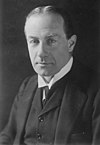
Stanley Baldwin, 1st Earl Baldwin of Bewdley, was a British statesman and Conservative politician who dominated the government of the United Kingdom between the world wars, serving as prime minister on three occasions, from May 1923 to January 1924, from November 1924 to June 1929, and from June 1935 to May 1937.

Quintin McGarel Hogg, Baron Hailsham of St Marylebone,, known as the 2nd Viscount Hailsham between 1950 and 1963, at which point he disclaimed his hereditary peerage, was a British barrister and Conservative Party politician who served as Lord Chancellor from 1970 to 1974 and again from 1979 to 1987.

Douglas McGarel Hogg, 1st Viscount Hailsham, was a British lawyer and Conservative politician who twice served as Lord Chancellor, in addition to a number of other Cabinet positions. Mooted as a possible successor to Stanley Baldwin as party leader for a time in the very early 1930s, he was widely considered to be one of the leading Conservative politicians of his generation.

The leader of the House of Lords is a member of the Cabinet of the United Kingdom who is responsible for arranging government business in the House of Lords. The post is also the leader of the governing party in the House of Lords who acts as the government party chairperson in the house. The role is always held in combination with a formal Cabinet position, usually one of the sinecure offices of Lord President of the Council, Lord Keeper of the Privy Seal or Chancellor of the Duchy of Lancaster. Unless the Leader is also a departmental minister, being Leader constitutes the bulk of their government responsibilities, but it has never been an independent salaried office. The Office of the Leader of the House of Lords is a ministerial department.

Viscount Hailsham, of Hailsham in the County of Sussex, is a title in the Peerage of the United Kingdom. It was created in 1929 for the lawyer and Conservative politician Douglas Hogg, 1st Baron Hailsham, who twice served as Lord High Chancellor of the Great Britain. He had already been created Baron Hailsham, of Hailsham in the County of Sussex, in 1928, also in the Peerage of the United Kingdom. Hogg was the son of the merchant and philanthropist Quintin Hogg, seventh son of Sir James Hogg, 1st Baronet, whose eldest son James McGarel-Hogg, 2nd Baronet was created Baron Magheramorne in the Peerage of the United Kingdom in 1887.

Earl Peel is a title in the Peerage of the United Kingdom. The Peel family descends from Robert Peel, eldest son of a wealthy cotton merchant. The family lands, known as Drayton Manor, in the County of Stafford would become more commonly known in modern-day as an amusement park. The family seat is Elmire House, near Ripon, North Yorkshire.

James Edward Hubert Gascoyne-Cecil, 4th Marquess of Salisbury,, known as Viscount Cranborne from 1868 to 1903, was a British statesman.

The Carlton Club is a private members' club in St James's, London. It was the original home of the Conservative Party before the creation of Conservative Central Office. Membership of the club is by nomination and election only.

Philip Cunliffe-Lister, 1st Earl of Swinton,, known as Philip Lloyd-Greame until 1924 and as The Viscount Swinton between 1935 and 1955, was a prominent British Conservative politician from the 1920s until the 1950s. He was notable through the 1940s and 1950s as being firstly the Minister for Aviation, and then being on the steering committee for the Convention on International Civil Aviation. he retired from politics in 1955 and his status was raised to an earldom.
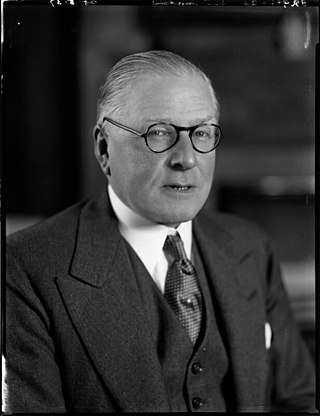
John Colin Campbell Davidson, 1st Viscount Davidson,, known before his elevation to the peerage as J. C. C. Davidson, was a British civil servant and Conservative Party politician, best known for his close alliance with Stanley Baldwin. Initially a civil servant, Davidson was private secretary to Bonar Law between 1915 and 1920. After entering parliament in 1920, he served under Baldwin as Chancellor of the Duchy of Lancaster between 1923 and 1924 and as Parliamentary and Financial Secretary to the Admiralty between 1924 and 1926. From 1926 to 1930 he was Chairman of the Conservative Party. He was once again Chancellor of the Duchy of Lancaster between 1931 and 1937, firstly under Ramsay MacDonald and from 1935 onwards under Baldwin. On Baldwin's retirement in 1937, Davidson left the House of Commons and was ennobled as Viscount Davidson. Despite being only 48, he never took any further active part in politics. His wife Frances, Viscountess Davidson, succeeded him as MP for Hemel Hempstead. Lord Davidson died in London in 1970.
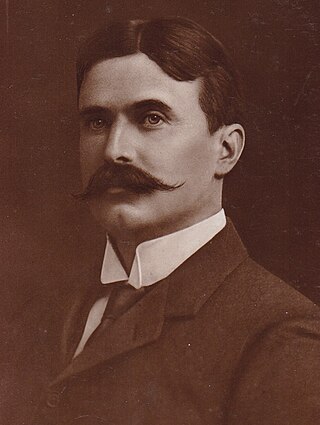
William Robert Wellesley Peel, 1st Earl Peel,, 2nd Viscount Peel from 1912 to 1929, was a British politician who was a local councillor, a Member of Parliament and a member of the House of Lords. After an early career as a barrister and a journalist, he entered first local and then national politics. He rose to hold a number of ministerial positions but is probably best remembered for chairing the Peel Commission in 1936–1937, which recommended for the first time the partition of the British Mandate of Palestine into separate Jewish and Arab states.

The National Government of 1937–1939 was formed by Neville Chamberlain on his appointment as Prime Minister of the United Kingdom by King George VI. He succeeded Stanley Baldwin, who announced his resignation following the coronation of the King and Queen in May 1937.
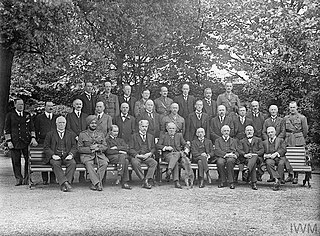
Liberal David Lloyd George formed a coalition government in the United Kingdom in December 1916, and was appointed Prime Minister of the United Kingdom by King George V. It replaced the earlier wartime coalition under H. H. Asquith, which had been held responsible for losses during the Great War. Those Liberals who continued to support Asquith served as the Official Opposition. The government continued in power after the end of the war in 1918, though Lloyd George was increasingly reliant on the Conservatives for support. After several scandals including allegations of the sale of honours, the Conservatives withdrew their support after a meeting at the Carlton Club in 1922, and Bonar Law formed a government.
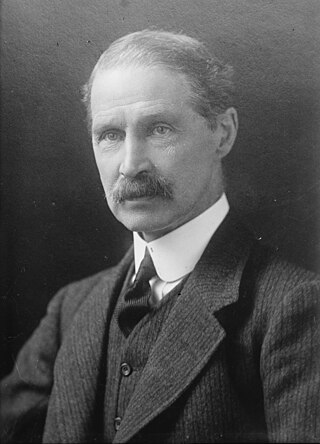
The Conservative Government of the United Kingdom that began in 1922 and ended in 1924 consisted of two ministries: the Law ministry and then the first Baldwin ministry.
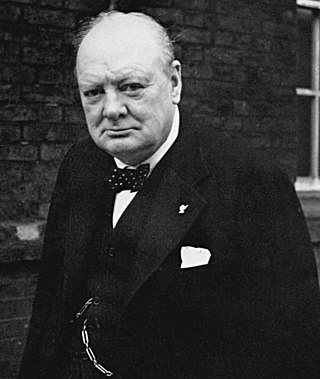
Winston Churchill formed the third Churchill ministry in the United Kingdom after the 1951 general election. He was reappointed as Prime Minister of the United Kingdom by King George VI and oversaw the accession of Queen Elizabeth II in 1952 and her coronation.

The Conservative government of the United Kingdom that began in 1957 and ended in 1964 consisted of three ministries: the first Macmillan ministry, second Macmillan ministry, and then the Douglas-Home ministry. They were respectively led by Harold Macmillan and Sir Alec Douglas-Home, who were appointed by Queen Elizabeth II.

The National Government of 1931–1935 was formed by Ramsay MacDonald following his reappointment as Prime Minister of the United Kingdom by King George V after the general election in October 1931.

The 1929 Dissolution Honours List was issued on 28 June 1929 at the advice of the outgoing Prime Minister, Stanley Baldwin.



















